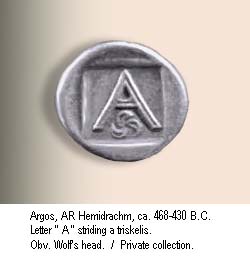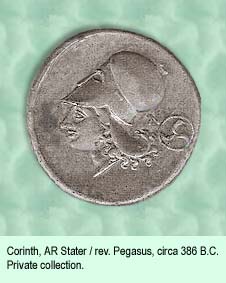|
|
Page III |
|
|
|
|
|
|
|
|
|
|
|
|
|
|
|
|
|
|
|
|
|
|
|
Contempt brings sedition and conspiracies,
as in oligarchies, where there exist many wielding no share
in administration. The rich, even in democracies, despising
the disorder and anarchy which forthcomes, hope bettering themselves
by the same means. As a result of poor administration, the democracy
was destroyed, as occured in Megara, where the power of the
people disappeared through anarchy and disorder; the same came
to pass at Syracuse prior to Gelon’s tyranny. |
|
|
|
Aristotle
|
|
|
|
|
|
|
|
|
|
|
|
|
|
|
|
Greek civilisation spread throughout the
ancient world via commerce, art, science, colonists and chaos, developing
Hellenistic kingdoms amidst a gradually expanding network and suddenly
surged full speed following the sword of Alexander the Great who
extended boundaries beyond sight or expectation. |
|
|
|
|
|
|
|
|
|
|
|
|
|
From European Greece,
closely timed with Pamphylia, Aegina,
a commercial state (now Aíyina), issued “turtle staters”,
a triskelis worked into reverses — fifth
century B.C. (Coins are viewable in Part 1). The British Museum
catalogue presents further samples. The Island’s solid ties with
Lydia may explain its early grasp of money, and its commerce with
Asia Minor conceivably furthered the symbol’s presence. (Lycia
similarly issued turtle staters 500-475 B.C.).
Aegina is conjectured the first minting state in European Greece,
the activity dating as Lydia’s, in the mid seventh century according
to the British Museum although other specialists announce the eighth
century. The Bibliothèque Nationale, Paris, possesses an Aeginetic
stater placed about circa 700 B.C. We
unfortunately do not have an image for this presentation. |
|
|
|
|
|
|
|
|
|
|
|
|
|
Controlling Siphnos
Island’s silver source, Aegina supplied currency throughout the
Peloponnesus during several hundred years. However, disaster struck
in the 5th century. Striving to preserve
her war threatened commerce, the island bowed before Persia,
an act wrathful Athens cruelly punished. Aegina lost not only the
triskelis but also her inhabitants, becoming thereafter a plaything
of the Fates, bandied from one dominating power to the other. It is
considered the birthplace of Aristophanes. |
|
|
|
|
|
|
|
|
|
|
|
|
| |
Pausanias the wanderer
wrote in the second century A.D. : |
|
|
|
|
|
|
|
|
|
|
|
|
|
“Of the Greek islands, Aegina is
the most difficult of access, for it is surrounded by sunken rocks
and reefs which rise up. Although the Aeginetans rose to great power,
so that their navy was superior to that of Athens, and in the Persian
war supplied more ships than any state except Athens, yet their prosperity
was not permanent but when the island was depopulated by the Athenians,
they took up their abode at Thyrea, in Argolis, which the Lacedaemonians
gave them to dwell in. They recovered their island when the Athenian
warships were captured in the Hellespont, yet it was never given them
to rise again to their old wealth or power.” |
|
|
|
|
|
|
|
|
|
|
|
|
|
|
|
A coining
pioneer, enterprising Euboea created
the widely employed Euboïc coin standard along with weights and
measures *5. “There is a text that
states Pheidon struck gold coins at Euboea, that is at the Heraion;
this text possibly reflects an effort to bridge the geographical gap
between the Heraion and the island of Aegin.”. This is quoted
from a most absorbing study: metrum.org /measures/heraion.htm. The
long island's bronze industry propelled it ahead neighbouring Greeks.
Two major cities were Chalcis and Eretria, significant metropoli of
antiquity. Euboean coins are frequently found around Attica, demonstrating
their close bonds. Euboean Chalkidic records earliest known, eighth
century Greek inscriptions. |
|
|
 |
|
|
|
|
|
|
|
|
|
|
|
|
|
|
|
|
|
|
One wonders whether
Euboea’s Gorgoneion triskelions suggest clues regarding Sicily’s
national emblem? Her colonies rose numerous in Thrace, Southern Italy
and Sicily (See Roman Sicily herein). The British Museum catalogue
provides the following information : |
|
|
|
|
|
|
|
|
|
|
|
|
|
“The uninscribed archaic coins
of the Euboïc standard with a diagonally divided incuse square
bear on their obverses, usually within a linear circle, the following
types: Owl, Horse walking, Hind part of walking horse, Forepart of
prancing horse, Amphora, Triskeles, Astragalos, Wheel of peculiar
form, Wheel of four spokes, Scarabaeus, Gorgoneion, Bull’s head
to front.” |
|
|
|
|
|
|
|
|
|
|
|
|
|
|
And of Corinth
Pausanias wrote: |
|
|
|
|
|
|
|
“When Bellerophontes migrated
to Lycia it is clear that the Corinthians none the less were
subject to the despots at Argos or Mycenae. By themselves they
provided no leader for the campaign against Troy, but shared
in the expedition as part of the forces, Mycenaean and other,
led by Agamemnon.” |
|
|
|
|
|
|
|
|
|
|
|
|
|
|
|
Mother of Sicilian
Syracuse, Corinth, ever competed with Athens but Rome became her Nemesis.
Star of the Peloponnesus, Strabo lauded her harbours and wealth whilst
mythology sets Helios and Poseidon quarrelling for possession of the
Isthmus. Meanwhile, the city-state industriously hauled ships over
a stone access (diolkos) stretched across the Isthmus and settled
a monetary system in the seventh century B.C.,
one of the first Greek cities striking coinage after Aegina and considered
the first in mainland Hellas to initiate bronze coinage in the
5th century B.C.
It is no surprise to find stylistically uniform coinage in her colonies
following the Corinthian monetary system when her official silver
staters portray the symbol [
15 ], alike a close neighbour, Phlius of
Phliasia in the 6th century B.C. — a territory
described by Pausanias, and homeland of sage Pythagoras. [ 16 ]
Having opposed Rome in 146 B.C. Corinth
suffered complete destruction. She remained as a ghost wandering the
Isthmus till 46 B.C. when Julius Caesar
revived the city as a Roman colony but the ashes of her destruction
flew away with memories we would have preferred keeping. |
|
|
|
|
|
|
|
|
|
|
|
|
|
|
“Speed royal Helen, away and away,
To Argos home, to the royal bay.” |
|
|
|
Euripides |
|
|
|
|
|
|
|
|
|
|
|
|
|
|
|
|
|
|
Ascertained
Greece’s second oldest city, Argos,
land of the flute, south of Corinth and Phlius, witnessed the childhood
of goddess Hera and that of the famed sculptor and bronze master,
Polycletus (Polykleitos). Birthplace of many famed personages such
as Perseus, the inhabitants, were once called Argives, a Homeric
term likewise designating all Greeks. Mythology
ties this city-state to Lycia and asia minor with Proetus 1 receiving
military aid from his father-in-law the Lycian King and Sthenelus
II sailing against Troy (13th century B.C.)
*4. Amphilochus I, equally active
midst this famed and furious battle, meets death within Soli, a Cilician
town. Plutarch describes ambitious Pheidon, King of Argos (8th
or 7th century B.C.) set upon breaking Corinth’s power.
Under this ruler, 750 B.C., Argos dominated
the Peloponnesus whilst Phoenician alphabetic script adapted itself
thereto.
The streamlined “A” silver triskelis specie of unknown value (5th century B.C.), mirrors an age of
Argolic revival and silver issues. [
14 ] This series shows the letter “A” striding differing
symbols, such as: a crescent, a dolphin, the Dioscuri, a club,
an eagle, and a trident whereunder the magistrate’s name, “DAMP”
takes shape. Foregoing the Persian wars, Sparta crippled Argos in
determinate defeat. Contrary to many triskelis sites, this one lives
on midst the cloud-reaching steps of an ancient theatre. A present-day
town encloisters whispering ancient secrets. |
|
|
 |
|
|
|
|
|
|
|
|
|
|
|
|
|
|
|
|
|
|
Opposite Aegina and
formerly her possession, Salamis
sits one nautical mile from Piraeus. Homer called Salamis “Salam”
or “Chalam” meaning peace or calm and his Illiad
introduces Salamis-born Ajax the Great. The island is also the birthplace
of Euripides and its bronze coinage reveals a triskelis.
After the Battle of Thermopylae (the “Hot Gates”) 480
B.C. Persian troops burned Athens whilst helpless Athenians
sought refuge upon Salamis, just an eye-view from Athens. [
73 ] Themistocles, heeding Delphian counsel, led the allied
fleet toward victory that same year. Thirty-one Hellenic League States
partook in this war. |
|
|
|
|
|
|
|
|
|
|
|
|
|
|
|
|
|
|
|
|
|
|
We find
the Attica triskelis though artefacts
and drawings such as upon shields. Inevitably we encounter the symbol
witnessing the Trojan war. A potter’s work details the image
adorning Achilles’s shield, circa 520-510
B.C. Weilding a triskelis shield with his free arm, Achilles
drags demised Hektor behind his chariot.This image is viewable at:
www.temple.edu/classics/troyimages. The hero was born in the Myrmidones,
in Phthia, Thessaly, yet this ware is Attican.*9 |
|
|
 |
|
|
|
|
|
|
|
|
|
|
|
|
|
|
|
|
|
|
|
|
An early
Athenian triskelis is studied
in the 1966 work of Kraay, C. and Max Hirmer : Greek Coins, pl.144,
coin no 340, catalogue entry page 325 [
45 ]. Interestingly, the didrachm displayed and dated circa
570-550 B.C. closely resembles the 6th
century Phlius didrachm above,
number 16. *16 |
|
|
 |
|
|
|
|
|
|
|
|
|
|
|
|
|
|
|
|
|
|
|
|
Certain
researchers mention a bronze Olympia
tripteral alongside early Athenian triskelis coins as symbolizing
the cult of Athena; elements of panathenaea. Processions took place
once every four years. Such a theory ties together triskeles observed
elsewhere, Aspendos or Syracuse for example, but nowise clarifies
other appearances adorning tombs, towers, battle-shields or the shield
Enceladus carries deflecting Athena’s spear. His shield is conspicuously
emblazoned with a triskelis. The Larousse Encyclopedia of Mythology,
offers this image of Enceladus whose life seems forfeit beneath Athena’s
menacing lance. The scene portrays the Gigantes battle
against almighty Olympians *10. When through
with him, Athena despatches Enceladus unto burial beneath Sicily.*11
Would Sicily’s symbol originate with such mythological concepts?
A protective Medusa-Gorgoneion after all adorned Athena’s shield
when she found it expedient. |
|
|
 |
|
|
|
|
|
|
|
|
|
|
|
|
|
|
 |
|
| Shield
of Enceladus |
|
|
|
|
|
|
|
|
|
|
|
|
|
|
|
|
|
|
|
|
|
|
|
|
|
|
|
|
|
|
|
|
|
|
|
|
|
|
|
|
|
|
|
|
|
|
|
|





